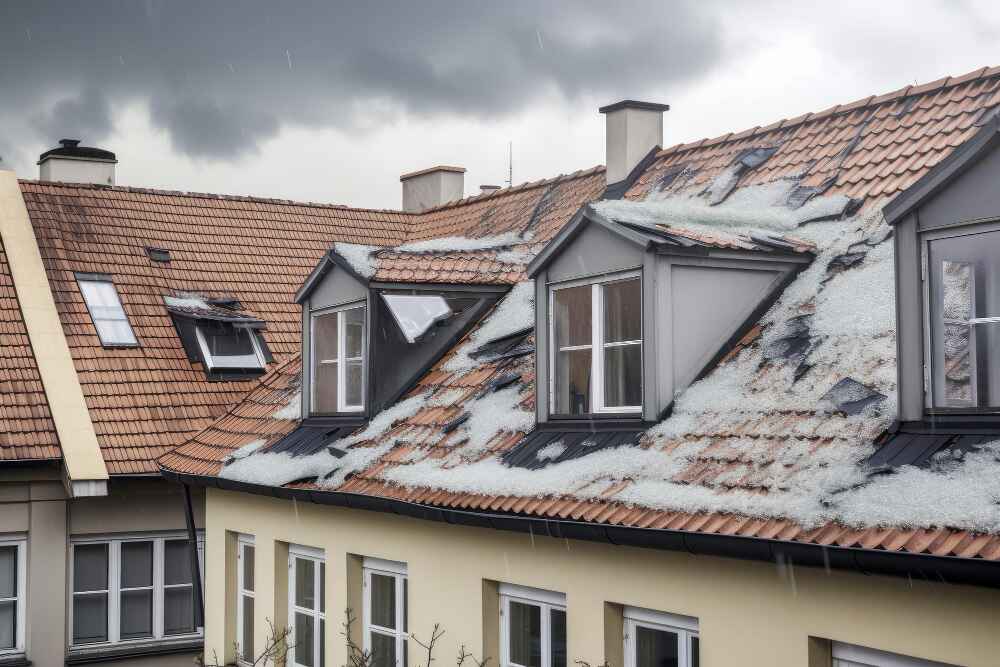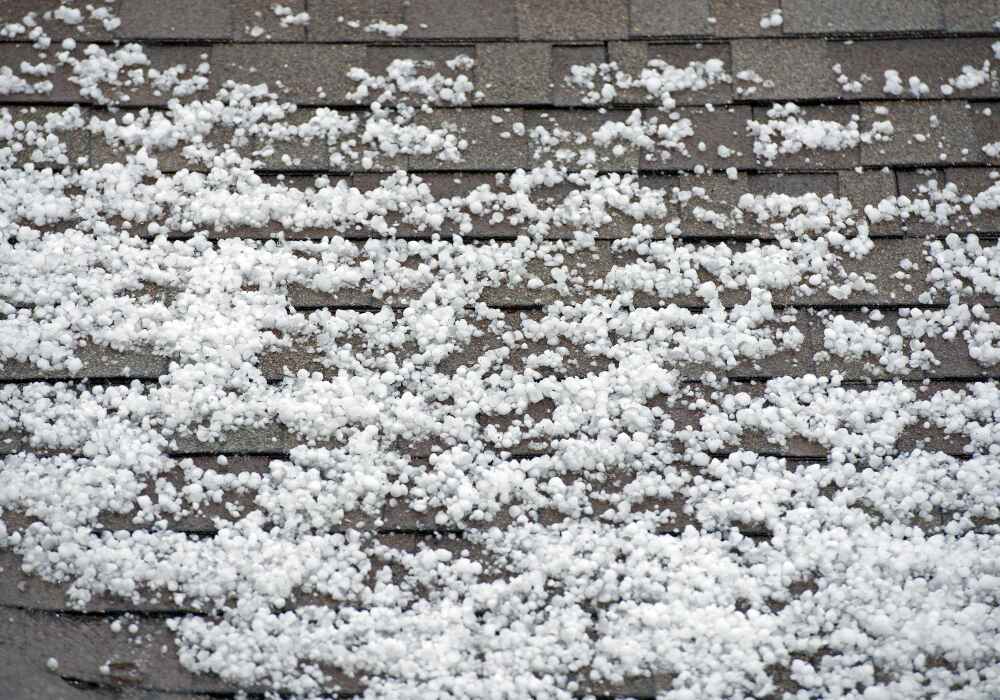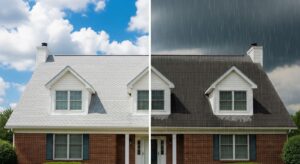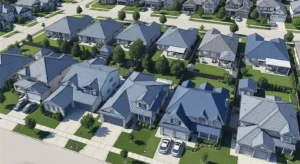Crack. Ping. Boom.
The sky opens, the hail comes crashing down — and just like that, you’re left with a hail damage roof, taking the brunt of nature’s wildest storm.
After the storm clears, the sun peeks out, and you step outside to assess the aftermath. Your siding? Fine. Your car? Maybe a few dings. But your roof?
That’s where things get tricky.
Hail damage to a roof isn’t always obvious. In fact, many homeowners only discover problems weeks (or even months) later — when a tiny leak turns into a major headache.
In this blog post, we’ll show you:
- How hail actually damages a roof
- What size hail can cause serious issues
- The key signs of damage (even if your shingles look okay)
- How to inspect your roof like a pro
- What to do next (especially if you’re thinking “Insurance?”)
Let’s dive in and help you stay ahead of costly repairs and unexpected drips. Read our most common roof repair issues blog.
How Does Hail Damage a Roof?
You might assume only softball-sized hail can hurt your home, but in reality, much smaller stones can wreak havoc depending on several factors.
Here’s how hail causes damage:
- Impact Force: Hailstones can strike shingles hard enough to bruise or crack them.
- Granule Loss: Shingles are coated with granules that protect the asphalt underneath. Hail knocks these loose.
- Cracking and Splitting: Especially on older or brittle shingles, hail can create cracks that let water in.
- Weakened Seal Tabs: Even if you don’t lose shingles immediately, loosened adhesive can cause them to fly off in the next storm.
Fun Fact: A single hailstorm can reduce your roof’s life expectancy by 5–10 years — even if you don’t see immediate damage.
What Size Hail Damages Roofs?
Not all hail is created equal. The bigger it is, the more likely it is to cause problems — but even small stones can do damage under the right conditions. Not sure how dangerous hail can be in your area? The National Weather Service Hail Guide breaks down how hail forms, how big it gets, and when to worry.
Hail Size Damage Chart:
Hail Size | Description | Likelihood of Roof Damage |
0.25″ (pea-sized) | Mostly harmless | Low |
1.0″ (quarter-sized) | May cause bruising on older shingles | Moderate |
1.5–2″ (golf ball–size) | Can crack shingles, dent vents | High |
2.5″+ (baseball-size) | Severe damage to all roof types | Very High |
Other Factors That Affect Damage:
- Wind speed and direction
- Roof age and material
- Roof pitch (flatter roofs get hit harder)
- Hailstone hardness (some are icy missiles)
Internal Tip: Considering a roof upgrade? Check out our Malarkey Shingles Review to learn about hail-resistant options.
What Does Hail Damage Look Like on a Roof?

Hail damage doesn’t always look like giant holes or missing shingles. Often, it’s sneaky.
Signs of Hail Damage to Asphalt Shingles:
- Bruising: Press on a spot and feel a soft dent, like an apple with a bruise.
- Granule Loss: Exposed black asphalt, especially in circular spots.
- Cracks: Shingles may look fine but have hairline fractures.
- Edges Lifted: Especially on three-tab shingles after hail hits the seal strip.
Other Materials:
- Metal Roofs: Look for small dents — they’re usually visible but hard to feel.
- Wood Shakes: Splits or fractures, especially along the grain.
- Tile/Slate: Cracked or broken pieces are more obvious but no less dangerous.
Pro Tip: Damage is often random and spread out, but usually concentrated on one side of the roof — wherever the wind pushed the hail hardest.
How to Spot Roof Hail Damage From the Ground (And When to Climb)
You can spot hail damage without getting on your roof — and in most cases, you probably should stay grounded (unless you’re experienced or extremely confident).
Signs You Can See Without Climbing:
- Dents in gutters or downspouts
- Dings on your mailbox, AC unit, or car
- Shingle granules in your downspout or gutter runoff
- Torn window screens
If these are present, your roof may have taken some hits too.
When to Get on the Roof (Or Call a Pro):
- After a major storm with golf ball–sized hail
- When you see daylight in the attic
- If you’re preparing to file a roof insurance claim
Internal Link: Learn how to file a claim with our Roof Damage Insurance Claim Process Guide.
Minor Hail Damage Roof – Still Worth Worrying About?
Short answer? Yes.
Even small hail damage can lead to:
- Slow leaks that cause mold or rot
- Insulation breakdown
- Energy inefficiency
- Roof warranty voids
Don’t fall for the “it’s just cosmetic” myth. Insurance adjusters know better — and so should you.
How to Identify Roof Hail Damage Like a Pro
DIY Inspection Tips:
- Look for uniformity: If one slope is worse than the others, hail might be the cause.
- Press gently on shingles: Feeling for “soft spots” is better than just looking.
- Use chalk on vents or metal flashing: It helps make dents visible.
- Document everything — you’ll want photos from multiple angles if you file a claim.
What Professionals Look For:
- Repetitive impact patterns
- Exposed matting
- Flashing and ventilation system damage
- Moisture beneath surface layers using infrared or moisture meters
Pro Move: Have a roofing contractor inspect it before the insurance adjuster. It gives you leverage. Read Professional guidelines for hail damage inspection.
Why Is Hail Damage Bad for a Roof?
Let’s break this down:
- Moisture Intrusion: Tiny cracks become big leaks after enough rain or snow.
- Accelerated Aging: Damaged shingles lose their protective granules, meaning your roof deteriorates faster.
- Compromised Protection: A single weakened shingle can fail during the next windstorm.
- Cost Creep: Today’s “minor” damage can turn into tomorrow’s “full roof replacement.”
Choosing the Right Hail Damage Roofers
The aftermath of a storm brings out the roofing cowboys — out-of-town crews chasing insurance payouts.
What to Look For:
- Local presence and physical address
- Certified, insured, and bonded
- Great online reviews and Better Business Bureau rating
- Warranty on work performed
- Willingness to help with insurance claims
Avoid These Red Flags:
- High-pressure sales tactics
- Demands for full payment upfront
- No written estimate
- No license or proof of insurance
FAQs About Hail Storm Roof Damage
How do I know if my roof has hail damage?
Start by looking for subtle signs: soft bruises on shingles, exposed black spots from granule loss, cracked edges, or dents in vents and flashing. These can be hard to spot from the ground, so if you’re unsure, schedule a professional inspection — they’ll use specialized tools like moisture meters or infrared imaging to confirm damage.
Can small hail really damage a roof?
Absolutely. Even hail as small as a quarter (1 inch) can bruise or weaken older or brittle shingles, especially on low-slope roofs. The damage may not be immediately visible, but over time it can lead to leaks, mold, or insulation issues.
Will my insurance cover hail damage?
Most homeowners’ insurance policies do cover hail damage, but the key is acting fast. The damage must be well-documented and reported within the policy’s time limits. Having a roofing contractor on-site before your adjuster arrives can help ensure you get a fair and thorough claim.
Should I replace or repair my roof after hail damage?
That depends on how extensive the damage is. Minor bruising might just require a localized repair, but if multiple slopes are affected or the structural integrity is compromised, a full replacement could be more cost-effective in the long run. A detailed inspection will give you the right path forward.
How long do I have to file a hail damage claim?
Most insurance providers allow up to 12 months to file, but some have tighter windows, as short as 6 months. Review your policy carefully, and don’t delay. Filing promptly improves your chances of coverage and faster repairs.
Final Thoughts: Hail Happens — Don’t Ignore It
Hailstorms are part of life, especially in high-risk regions. But you don’t have to let a hail damage roof silently wreck your home.
Even if your shingles look fine, that doesn’t mean your roof escaped unharmed. A hail-damaged roof can hide issues like cracks, granule loss, or moisture intrusion.
Check for signs. Schedule an inspection. Document everything.
You may be eligible for an insurance-funded repair or full roof replacement, with little or no out-of-pocket cost.
Don’t wait for the drip.
Book a professional hail damage roof inspection today and stay one step ahead of costly repairs.






